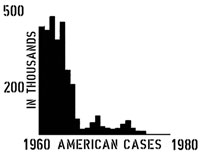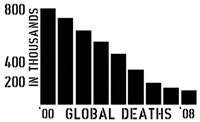About Measles
Measles is an extremely contagious virus spread through direct and indirect contact with airborne droplets (coughing, sneezing) from an infected individual. Symptoms begin 1-2 weeks after exposure, and generally include:
bloodshot eyes, cough, fever, light sensitivity (photophobia), muscle pain, rash (usually appears 3 – 5 days after the first signs of being sick; may last 4 – 7 days; usually starts on the head and spreads to other areas, moving down the body; may appear as flat, discolored areas (macules) and solid, red, raised areas (papules) that later join together; itchy), redness and irritation of the eyes (conjunctivitis), runny nose, sore throat, tiny white spots inside the mouth (Koplik’s spots).
 Before the 1963 introduction of the first vaccine, virtually everyone contracted the measles at some point. Measles itself is not particularly deadly, but the immune system can become compromised through co-morbidity (being sick with something else), or poor nutrition. These two factors (co-morbidity and poor nutrition) help to explain why measles can be so devastating in developing countries. After the introduction of the vaccine in the United States in 1963 (and an improved vaccine in 1968) incidence dropped dramatically. As you can see from the graph at right [1] incidence dropped from nearly 500,000 cases at the advent of the vaccine, to virtually zero by the 1980s.
Before the 1963 introduction of the first vaccine, virtually everyone contracted the measles at some point. Measles itself is not particularly deadly, but the immune system can become compromised through co-morbidity (being sick with something else), or poor nutrition. These two factors (co-morbidity and poor nutrition) help to explain why measles can be so devastating in developing countries. After the introduction of the vaccine in the United States in 1963 (and an improved vaccine in 1968) incidence dropped dramatically. As you can see from the graph at right [1] incidence dropped from nearly 500,000 cases at the advent of the vaccine, to virtually zero by the 1980s.
Through the 1990s measles was claiming as many as a million (or more) lives per year in the developing world, and measles is still the single leading cause of blindness among children in developing countries (as many as 60,000 cases per year[2]). The Red Cross and World Health Organization formed the Global Measles Initiative in 2001, aimed at eradicating measles worldwide.
 The good news? Global measles deaths have dropped from more than 2,000 per day to a fraction of what they were. Deaths in Africa were decreased by 93% between 2001 and 2008.
The good news? Global measles deaths have dropped from more than 2,000 per day to a fraction of what they were. Deaths in Africa were decreased by 93% between 2001 and 2008.
The bad news? 450 children still die of measles every single day. One every three minutes. The Measles Initiative has made a lot of progress, but the job isn’t done yet. With continued work we can eradicate measles in the next few years. Please help.
It costs less than $1 to vaccinate a child against measles.
W.H.O.’s AFR (African Region) initially set a goal of reducing measles deaths by 50% (of their 1999 value) by 2005[3]. This goal was more than met, and a new goal of 90% reduction (of 2000 value) was set (and achieved in 2006)[3]. Nearly 700 million children have been vaccinated, and measles coverage increased from 57% to 73% between 2001 and 2008[3].
Although measles is still a major problem, causing around 150,000 deaths per year, significant progress has been made toward ending measles — we are very excited to be a part of the solution. Please join us in supporting whatever way you can: by donating, by hosting a fundraiser, or simply by telling others about the Global Measles Initiative and our project.
[1] Data from Pediatrics VOL 114 NO.4 OCT 2004 PP 1065-1069
[2] Survey of Ophthalmology Volume 49, Issue 2, Pages 243-255 (March – April 2004)
[3] Morbidity & Mortality Weekly Report SEPT 25 2009, VOL.58 (37): 1036-1041








